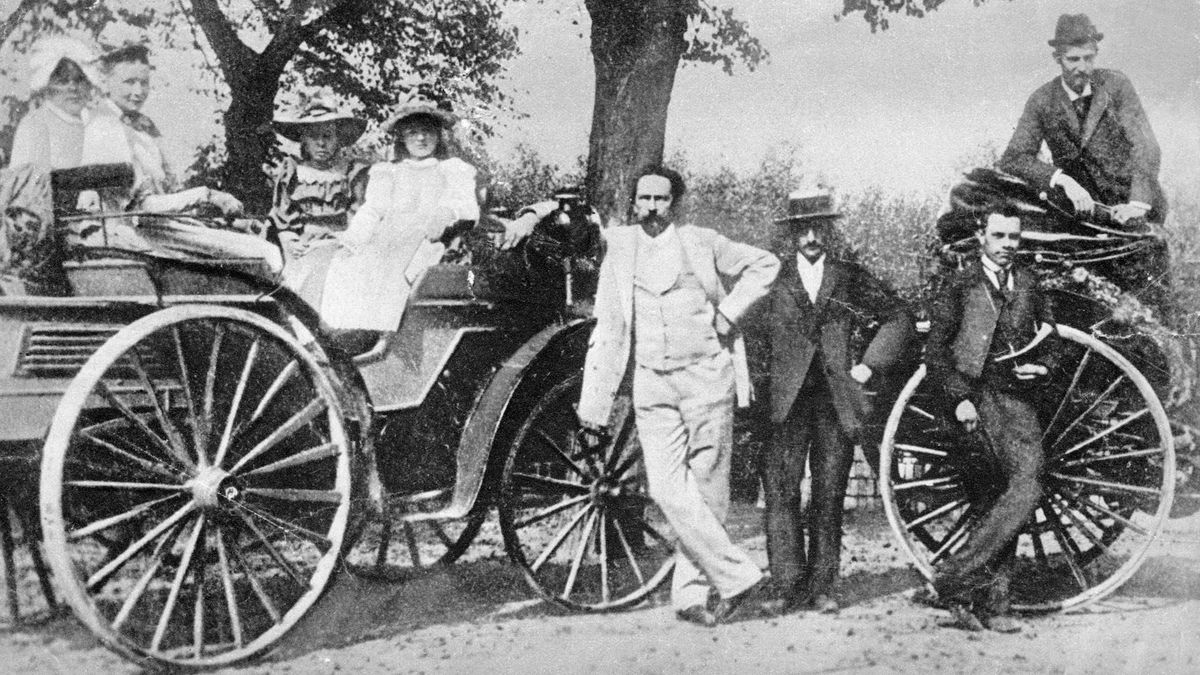Who invented the car? The history of the automobile
Discover the complex history of the automobile, from early self-propelled vehicles to Karl Benz's invention of the first modern car, and explore the key innovators who shaped the cars we drive today.

Working out who invented the car is a long and winding road, and pinpointing a single person responsible is not a simple matter. If you rewind the development of cars past GPS, past antilock brakes and automatic transmissions and even past the Model T, eventually you'll get to the Benz Motor Car No. 1, the missing link between cars and horse-drawn buggies.
Karl Benz patented the three-wheeled Motor Car, known as the "Motorwagen," in 1886. It was the first true, modern automobile, meaning Benz is most often identified as the man who invented the car. Benz also patented his own throttle system, spark plugs, gear shifters, a water radiator, a carburetor and other fundamentals to the automobile. Benz eventually built a car company that still exists today as the Daimler Group.
The first car: Who really invented it?
"We generally think of the 1886 Benz Patent-Motorwagen as the first proper car," Tom Standage, author of "A Brief History of Motion: From the Wheel, to the Car, to What Comes Next" (Bloomsbury Publishing, 2021) told All About History magazine. Standage said that Benz used bicycle parts to build a vehicle around an internal combustion engine. "Its innovation required lots of people to try different things and, although this seems obvious in retrospect, it wasn’t at the time," he said.
Benz patented the first gasoline-powered car, but he wasn't the original visionary of self-propelled vehicles. Even the definition of the word "car" has evolved over time.
"At the end of the 19th Century, a car was a “streetcar,” i.e. a tram," Standage said. "Streetcars before that were 'horse cars' which were omnibuses pulled by horses on rails. The word 'car' became available to what was previously called a 'horseless carriage' or possibly a motor car. The 'automobile', as they call it in America, was itself an import from the French."
Here are some important innovations that paved the way for the automobile:
- Leonardo da Vinci had sketched a horseless, mechanized cart in the early 1500s. Like many of his designs, it wasn't built in his lifetime. However, a replica is on display at the Chateau Clos Lucé, Leonardo's last home and now a museum.
- Sailing chariots, which were propelled by the wind, were in use in China when the first Westerners visited. In 1600, Simon Steven of Holland built one that carried 28 people and covered 39 miles (63 km) in two hours.
- French inventor Nicholas-Joseph Cugnot built a self-propelled vehicle with a steam engine in 1769. The cart, designed to move artillery pieces, moved at a walking pace (2 mph or 3.2 km/h) and had to stop every 20 minutes to build a new head of steam.
The 1886 Benz Patent-Motorwagen
Internal combustion engines: A key to modern cars
Vital to the modern automobile is the internal combustion engine. This type of engine uses an explosive combustion of fuel to push a piston within a cylinder. The piston's movement turns a crankshaft that is connected to the car's wheels of a drive shaft. Like the car itself, the internal combustion engine has a long history. The Benz Patent Motorwagen was the first successful automobile to use an internal combustion engine, but it relied on many other innovations in the field of internal combustion engines:
- 1680: Christiaan Huygens, better known for his contributions to physics and astronomy, designed but never built an internal combustion engine fueled by gunpowder.
- 1824: Englishman Samuel Brown altered a steam engine to burn gasoline and put it on a carriage, but this proto-automobile also never gained widespread adoption.
- 1858: Jean Joseph-Etienne Lenoir patented a double-acting, electric spark-ignition internal combustion engine fueled by coal gas. He improved on that engine so it would run on petroleum, attached it to a three-wheeled wagon and traveled 50 miles.
- 1873: American engineer George Brayton developed a two-stroke kerosene engine. It is considered to be the first safe and practical oil engine.
- 1876: Nikolaus August Otto patented the first four-stroke engine in Germany.
- 1885: Gottlieb Daimler of Germany invented the prototype of the modern gasoline engine.
- 1895: Rudolf Diesel, a French inventor, patented the diesel engine that was an efficient, compression ignition, internal combustion engine.
Karl Benz: The pioneer who revolutionized automobiles

Karl Benz gets the credit for inventing the automobile because his car was practical, used a gasoline-powered internal-combustion engine and worked like modern cars do today. Benz was born in 1844 in Germany. He was admitted to the University of Karlsruhe at age 15 and graduated in 1864 with a mechanical engineering degree.
Benz's first venture of an iron foundry and sheet-metal workshop flopped. However, his new bride, Bertha Ringer, used her dowry to fund a new factory to build gas engines. With the profits Benz was free to start building a horseless, gas-powered carriage.
Benz had built three prototypes of his Motor Car in private by 1888, when Bertha decided it was time for some press. Bertha took the latest model in the early morning and drove her two teenage sons 66 miles (106 kilometers) to her mother's home. She had to improvise repairs along the way with shoe leather, a hair pin and her garter.
The successful trip showed Benz how to improve the car, and showed a dubious public that automobiles were useful. Benz demonstrated the Model 3 Motorwagen at the World's Fair in Paris the following year.
Benz died in 1929, just two years after he merged with fellow car-maker Gottlieb Daimler's company to form what is today the Daimler Group, manufacturer of the Mercedes-Benz.
The evolution of electric cars

Electric cars were available in the middle of the 19th century, but fell out of favor after Henry Ford developed his Model T, according to the U.S. Department of Energy. But in recent years, electric cars have made a comeback. About 1.4 million electric cars were sold in the United States in 2023 , according to the International Council on Clean Transportation. This technology, like the internal combustion engine, also has a long history that is difficult to point to one inventor.
Robert Anderson, a Scottish inventor, and Thomas Davenport, an American inventor, independently designed rudimentary electric cars in the 1830's. These early models used non-rechargeable batteries; the first rechargeable battery was invented in 1865 by Gaston Plante, a French physicist. Adapted from the U.S. Department of Energy, a more detailed timeline of the history of electric cars includes:
- 1891: William Morrison of Des Moines, Iowa, was the first to successfully build an electric car in the United States.
- 1895: The first automobile race in the United States — a 52-mile "dash" from Chicago to Waukegan, Ill., and back, which took the winner 10 hours 23 minutes (average speed 5 mph / 8 km/h) — featured two electric cars, according to Smithsonian magazine.
- 1899: Camille Jénatzy, a Belgian race car driver, built and raced an electric car, setting a new land speed record of 62 mph (100 km/h). His car was called La Jamais Contente (which means "the never satisfied").
- 1900: Ferdinand Porsche, a German automotive engineer, invented the first hybrid car, according to the official Porsche website. The New York City taxi service had about 60 electric cars, and approximately one third of cars in the United States were electric, according to the Department of Energy.
- 1907: Thomas Edison developed a nickel-alkaline battery that was more durable and less hazardous than the lead-acid battery used in cars, according to Rutgers University. The battery didn't appeal to most consumers because it had a higher initial cost, but it was used in the delivery trucks of several companies due to its durability and longer ranges.
"At the beginning of the 20th Century, electric cars were very briefly more popular than internal combustion engine cars in America. However, they had very bad batteries," Standage said. "Electric cars are only good today because of batteries that were initially developed for laptops and camcorders."
When Henry Ford introduced the Model T in 1908, the inexpensive and high quality gasoline powered car became very popular and the decline of electric cars began, according to the Department of Energy. By the 1920s, gasoline had become cheaper and more readily available, and more Americans were traveling greater distances. Electric cars didn't have the range that gas-powered cars had, and electricity was still not readily available in many rural cities, making the gasoline-powered cars the automobiles of choice.
In 1976, Congress passed the Electric and Hybrid Vehicle Research, Development, and Demonstration Act due to rising oil prices, gasoline shortages and dependencies on foreign oil. The Toyota Prius, developed and released in Japan in 1997, was the world's first mass-produced hybrid car and was available around the world by 2000. The Honda Insight hybrid car was released in the United States in 1999.
Tesla Motors began development and production on a luxury all-electric car that would travel more than two hundred miles on a single charge in 2003 with the first model released in 2008. The Chevrolet Volt, released in 2010, was the first available plug-in hybrid that used the gasoline engine to extend the range of the automobile when the battery was depleted. The Nissan LEAF was also released in 2010 and was more readily available to the public than Tesla's Model S.
The future of cars: Electric and autonomous vehicles
While electric cars waned in popularity throughout much of the 20th century, the electric vehicle market has entered a new period of growth and evolution. Advancements in battery technology have made electric vehicles cheaper and more efficient over longer distances, and more automakers than ever are adding fully electric and hybrid vehicles to their lineup. According to the International Energy Agency, from 2020 to 2023, the total share of electric cars grew from around 4% to 18%.
While the shift towards electric vehicles has been driven in part by the climate crisis, they do still have some sustainability pitfalls. Electric vehicles generate less fossil fuel emissions and a lower carbon footprint than gasoline-powered cars, but the environmental impact of battery production remains a concern.
The field of autonomous or driverless vehicles is also rapidly advancing. Companies like Waymo are pushing the boundaries with fully driverless cars already operating in select urban areas. However, challenges remain, including the complexity of navigating unpredictable environments, regulatory hurdles, and public trust.
Additional resources
The technology of cars has developed at incredible speeds, as our breakdown of Formula 1 race cars exemplifies. If all of this car technology information has got you interested in learning more, then our examination of the gearbox and how it works will be for you.
Sign up for the Live Science daily newsletter now
Get the world’s most fascinating discoveries delivered straight to your inbox.

- Jonathan GordonEditor, All About History
- Marilyn PerkinsContent Manager












